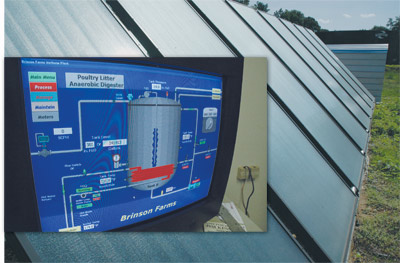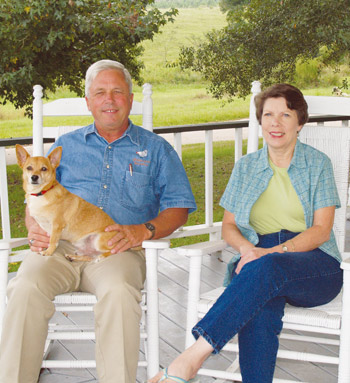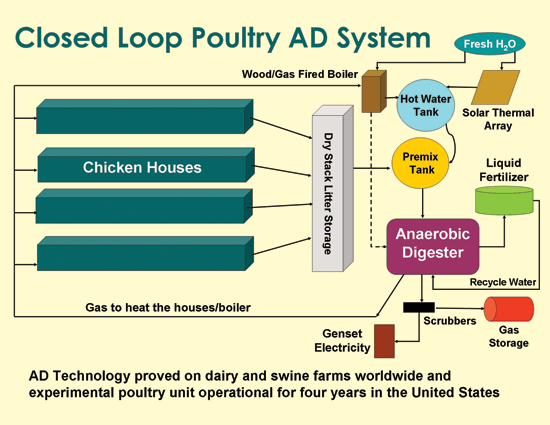Using his technical background in the military, Mississippi broiler producer John Logan developed a methane digester that has reduced his fuel costs, litter-disposal problems and environmental concerns. His next project: a cost-effective methane digester for commercial use on broiler operations.

Background photo: Solar thermal panels aid in heating water to 140°, which in turn heats the chicken litter for conversion to methane. Foreground: From his computer, John Logan can monitor and control the digester processing systems.
Photo by Greg Gibson, Mississippi Farm Bureau Federation
Conquering tough challenges is nothing new to John Logan. For nearly four decades, the retired Army colonel led complex information technology, logistics and transportation projects around the globe — while juggling a career in computer marketing and management, and serving on university faculties.
So, in 1994, when he and his wife, Bettye, decided to return to her family’s farm at Prentiss, Miss., they weren’t daunted by the challenges that awaited them.
"The farm had sat idle for 30 years, and the soil really needed work," recalls Logan. Despite having no poultry experience, a recent consulting gig had piqued his interest in the poultry business. He envisioned building a broiler business as the center of the farming operation.
Challenge No. 1: Building a Business
Within a year, the Logans had constructed five chicken houses and were raising broilers for Tyson Foods. "I needed something that would provide a dependable cash flow, and from there we could grow the other farm operations," says Logan. For the first five years, the couple ran the business with only the help of a nephew. Over time, they added five more houses, accommodating 270,000 broilers.

John and Bettye Logan have transformed their family farm into a place for pioneering energy and by-product resources.
Photo by Therese Apel
Likewise, the challenges expanded. "I realized that labor and utilities were the only two items I had control over," says Logan, who solved the labor challenge by hiring two full-time employees.
Challenge No. 2: Controlling Energy Costs
But solving the utility-cost challenge and his other primary challenge — what to do with the never-ending supply of poultry litter — would take a bit more ingenuity.
"Fuel costs are the biggest costs for the poultry business," says Land Bank South Vice President Steve Lazenby, whose cooperative helps to finance Logan’s Brinson Farms operations. "Propane has doubled in recent years, and that’s hitting poultry producers hard. If you can find a way to hold those costs in line, that’s big."
At Brinson Farms alone, the energy bill was exceeding $75,000 per year. Statewide, it costs more than $40 million in propane, natural gas and electricity to run Mississippi’s 7,000-plus poultry houses.
Challenge No. 3: A Use for Poultry Litter
At the same time, with fears of mad cow disease escalating, poultry operators like Logan faced a U.S. Food and Drug Administration ban on feeding poultry litter to cattle. In addition, concerns were mounting over high phosphorous levels resulting from the use of poultry litter as fertilizer on cattle-grazing lands. "There are farms that are condemned because of the high phosphorous levels," says Logan. "It will take three to five years to get that land back into production."
"I went from one month of $5,000 in power bills to the electric company owing me $250 for the excess power I generated."
– John Logan
An avowed environmentalist, Logan was increasingly concerned with creating a sustainable operation. "What happens if the government outlaws the use of chicken litter on the ground?" says the two-time Tyson Environmental Stewardship Award recipient. "It has happened in other states already, and it is likely to eventually happen in all the states bordering the Gulf Coast."
Solution No. 1: Be Bold
The solution to both challenges, Logan believed, was to find a way to use the endless supply of poultry litter to reduce fuel costs on the farm and solve the environmental issues.
Having traveled the world with the military, he had seen methane digesters in use throughout Europe and Asia. "They have been using digesters there for years, and the more I looked into it, the more convinced I was that I had a manure product suitable for a digester," he says.
In the U.S., methane-gas-capture systems already had proven technically and economically viable on 14 swine farms, 15 dairies and 2 caged-layer operations — but never on a broiler farm.
Solution No. 2: Do the Research
When he first approached state leaders with the idea of building a poultry-litter methane digester, the response was skeptical. "At first, the state felt the manure would have too many wood shavings in it to be viable," he says. Logan was not deterred. Tyson Foods had long ago reduced the use of wood shavings from their growers’ houses to help strengthen the chicks’ immune systems.
"We were looking for grant money but everyone was skeptical of whether a digester would work with poultry," he recalls. "With my technical background, I knew that you don’t just jump into something like this without good solid research." So, research it, he did.
Logan enlisted the help of Dr. Richard Vetter, the consultant who helped develop the caged-layer farm’s digester. He worked with experts at Mississippi State and West Virginia State universities for two years to cultivate the exact methanigen bacteria needed to output methane and a liquefied fertilizer. He brought in an electrical and computer engineer and a microbiologist to prove the system.
"Once we started, we flew all over the U.S. looking at digesters in operation at dairy and swine farms. We were able to accumulate a lot of information that helped us design the system," he notes.
Solution No. 3: Get the Funding
The data did its job. While Land Bank South provided seed money to start up the venture, most funding has come through grants. Among them are a $500,000 Mississippi Development Authority grant to develop the system; a Department of Energy grant earmarked for Logan to conduct educational seminars ("We’ve done a zillion of those," he says); a U.S. Department of Agriculture (USDA) renewal energy grant to build a solar system for fresh-water heating; a USDA conservation initiative grant for the computerization; and a value-added grant for organic-fertilizer marketing studies.
Solution No. 4: Be Commercially Viable
Today, methane gas from Logan’s digester fuels two power generators and heats Brinson Farms’ poultry houses. "I went from one month of $5,000 in power bills to the electric company owing me $250 for the excess power I generated," Logan says.
One ton of chicken litter produces more than 5 million BTUs of methane gas. His excess power is sold on the Mississippi electric grid at 3.5 cents per KwH. Projecting that the system will offset his annual energy costs by $98,000, Logan expects full payback in seven years.
With commercial development of the first two units under way in Mississippi, farmers in North Carolina, Georgia, Alabama and Louisiana are keeping a close watch.
"We’re working on developing a replicable on-farm system with a cost below $400,000," Logan says. "There are many tax credits to help make the system cash flow, and this system gives the farmer an additional source of revenue and alleviates the issue of farmers having to be concerned about phosphorous plans, showing what they will do with their poultry litter."
How the System Works
John Logan currently has a patent pending for the poultry-methane digester, the only one of its kind in existence, as well as for the process and the bacteria. Generally, here’s how it works:
Chicken litter is moved from the chicken house to dry-stack-litter storage. Solar panels, or fuel-wood cut from the farm, heat up to 2,500 gallons of fresh water per day from the farm’s reservoir or well. Chicken litter is mixed with the 140° water and moved into the anaerobic digester (AD), where it is mixed with the precise strain of bacteria needed to output methane and a highly concentrated liquefied fertilizer. The bacteria are concerned only with carbon, but taking the hydrogen sulfide out of the gas eliminates the odor in the fertilizer.
The methane passes through scrubbers and is compressed into the gas storage tank or directly fuels generators, where it can be used for on-farm heat and electricity. Excess power may be transferred to the electric grid for commercial sale. The entire system is computer-controlled with remote monitoring and manual overrides.

- Sue Durio